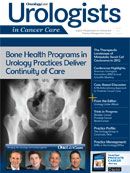Urology Under Attack
As we head into the sweltering days of summer, physicians-and urologists in particular-face a series of challenges that can potentially impact the way we practice and how we manage our patients.
Raoul Concepcion, MD
Editor-in-Chief of
Urologists in Cancer Care
Director of Clinical Research Urologic Surgeon Urology Associates, PC Nashville, TN
As we head into the sweltering days of summer, physicians—and urologists in particular—face a series of challenges that can potentially impact the way we practice and how we manage our patients. No faction is immune, academic versus independent, solo practitioner versus large group, employed versus self-employed urologist.
At a national level, we are all anxiously waiting the Supreme Court ruling on the individual mandate that requires all citizens to purchase health insurance and the constitutionality of such a provision as set forth in Patient Protection and Affordable Care Act. If, in fact, this controversial amendment is deemed unconstitutional, then the court must decide if the law can stand if this portion of the legislation is stripped from the Act. With this issue looming in the midst of the Presidential election, inertia could possibly set in with no significant healthcare reform introduced, leaving many of us wondering what is next and having to grapple with the mounting pressure of diminishing reimbursement and rising overhead.
Specific to the field of urology, we are all aware of the recent recommendation rendered by the US Preventive Services Task Force (USPSTF) downgrading the routine use of PSA in the early detection of prostate cancer. Without recapitulating all that has been published and submitted by various societies across the country, including the American Urological Association (AUA), Large Urology Group Practice Association (LUGPA), American Association of Clinical Urologists (AACU), and many patient advocacy groups, this single act threatens to roll back all the progress that has been made in reducing the mortality rate of prostate cancer over the past 20 years.
In my mind, this is reprehensible. However, the good news is that as we go to press, a urology delegation from the AUA and AACU was successful in lobbying the American Medical Association House of Delegates, making note that the USPSTF failed to take into account public comments submitted by specialists and that there were no urologists or oncologists on the panel.
Although opposed by certain primary care organizations, the tireless efforts of many of our peers resulted in a directive where the AMA encourages the USPTSF “to implement procedures that allow for meaningful input on recommendation development from specialists and stakeholders in the topic area under study.” Many thanks to Bill Gee, Willie Underwood, Aaron Spitz, and Roger Satterthwaite for their concerted efforts.
Over the past few years, it seems that the urology community has been under constant attack from colleagues outside of our specialty. Physician ownership and over-utilization of advanced imaging and radiation therapy were the first issues to be brought into the public spotlight. The most recent salvo was delivered by a noted Washington, DC economist, hired by a subspecialty organization, questioning our standard of care and the use transrectal ultrasound guided needle biopsy of the prostate and the number of cores taken to make a determination of prostate cancer. Thanks to the efforts of LUGPA, with data input from many large integrated groups across the country, these arguments, based on faulty and suspect data, were summarily dismissed on The Hill.1
The field of medicine faces many challenges as we move forward in the 21st century. Given the economic situation and the rising national debt crisis in this country, many outsiders are looking at ways to stifle technology and limit or ration care. The rapid explosion of the new therapeutics for advanced prostate cancer will no doubt bring into question the potential rising costs to treat this disease.
Given the lack of clear pathways and sequencing of these multiple agents, it seems prudent that we, as a specialty, begin to work cooperatively with our urologic peers to start the difficult and arduous task of data mining and collection. We need to determine the ideal patient profiles—irrespective of disease state—that will benefit from these new agents, and which therapies are clearly more efficacious and justify a higher price tag.
Hopefully, a well-designed electronic health record will help facilitate such a project, which will take years and a commitment, both personal and financial, from all involved. However, if we, as the recognized experts and thought leaders in the field, do not take the initiative, it will be mandated by bureaucrats, which will more than likely result in suboptimal care for our patients.
Reference
1. Urologists debunk misleading, grossly inaccurate prostate cancer biopsy study [press release]. Tallahassee, FL: Large Urology Group Practice Association; April 13, 2012.




